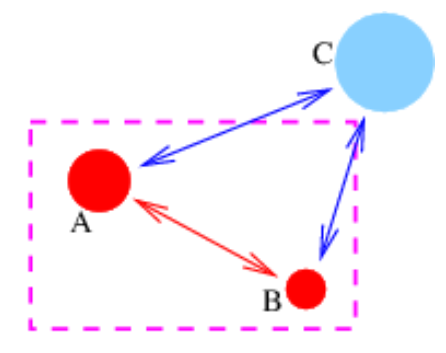10.2: Newton’s Third Law
- Page ID
- 32985
Newton’s third law states that if particle A exerts a force F on particle B, then particle B exerts a force -F on particle A. Newton’s third law makes it possible to apply Newton’s second law to systems of particles without considering the detailed interactions between particles within the system.

For instance, if we (arbitrarily) define the system in figure 10.1 to be the particles A and B inside the dashed lines, then we can divide the forces acting on these particles into internal and external parts:
\[\mathbf{F}_{A}=\mathbf{F}_{A-\text { internal }}+\mathbf{F}_{A-\text { external }}=\frac{d \mathbf{p}_{A}}{d t}\label{10.2}\]
\[\mathbf{F}_{B}=\mathbf{F}_{B-\text { internal }}+\mathbf{F}_{B-\text { external }}=\frac{d \mathbf{p}_{B}}{d t}\label{10.3}\]
Adding these equations together results in the net force Fnet being equal to
\[\mathbf{F}_{A-\text { internal }}+\mathbf{F}_{A-\text { external }}+\mathbf{F}_{B-\text { internal }}+\mathbf{F}_{B-\text { external }}=\frac{d}{d t}\left(\mathbf{p}_{A}+\mathbf{p}_{B}\right)\label{10.4}\]
However, the internal interactions in this case are A acting on B and B acting on A. These forces are equal in magnitude but opposite in direction, so they cancel out, leaving us with the net force equal to the sum of the external parts, \(\mathbf{F}_{\text {net }}=\mathbf{F}_{\text {A-external }}+\mathbf{F}_{\text {B-external }}\). The external forces in figure 10.1 are the force of C on A and the force of C on B. Defining the total kinetic momentum of the system as the sum of the A and B momenta, \(\mathbf{p}_{\mathrm{tot}}=\mathbf{p}_{\mathrm{A}}+\mathbf{p}_{\mathrm{B}}\), the above equation becomes
\[\mathbf{F}_{n e t}=\frac{d \mathbf{p}_{t o t}}{d t}\label{10.5}\]
which looks just like Newton’s second law for a single particle, except that it now applies to the system of particles (A and B in the present case) as a whole. This argument easily generalizes to any number of particles inside and outside the system. Thus, for instance, even though a soccer ball consists of billions of atoms, we are sure that the forces between atoms within the soccer ball cancel out, and the trajectory of the ball as a whole is determined solely by external forces such as gravity, wind drag, friction with the ground, and the kicks of soccer players.
Remember that for two forces to be a third law pair, they have to be acting on different particles. Furthermore, if one member of the pair is the force of particle A acting on particle B, then the other must be the force of particle B acting on particle A. A counterexample would be gravity and the upward normal force acting on a mass sitting on a table; these forces are equal and opposite in the stationary case, but act on the same object, and therefore do not constitute a third law pair. However, the upward normal force of the table on the mass and the downward normal force of the mass on the table would be a third law pair.


